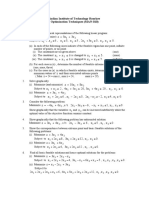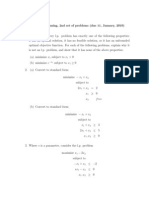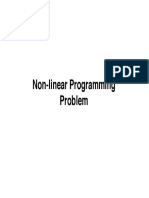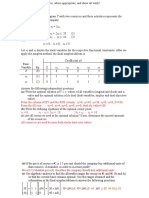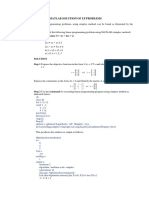Sheet 6 PDF
Sheet 6 PDF
Uploaded by
Iniyan I TCopyright:
Available Formats
Sheet 6 PDF
Sheet 6 PDF
Uploaded by
Iniyan I TOriginal Title
Copyright
Available Formats
Share this document
Did you find this document useful?
Is this content inappropriate?
Copyright:
Available Formats
Sheet 6 PDF
Sheet 6 PDF
Uploaded by
Iniyan I TCopyright:
Available Formats
Indian Institute of Technology Roorkee
Optimization Techniques (MAN-010)
Exercise-6
1. Consider the LPP
Max z = 3x1 + 2 x2 + 5 x3
s/t x1 + 2 x2 + x3 ≤ 430, 3x1 + 2 x3 ≤ 460, x1 + 4 x2 ≤ 420, x1 , x2 , x3 ≥ 0.
Given that x2 , x3 , x6 (slack variable corresponding to constraint 3) form the optimal basis
and inverse of the optimal basis is, row-wise; ½, -1/4, 0; 0, ½ 0; -2, 1, 1. Form the
optimal table based on this information.
2. In problem 1, find the optimal solution if the objective function is changed to
(i) z = 4 x1 + 2 x2 + x3 (ii) z = 3x2 + x3
3. In problem 1, a fourth variable is added with the technological (constraint) coefficients as 3,
2 and 4. Determine the optimal solution if the profit per unit of the new variable is given as 5
and 10.
4. Solve this problem using big M-method.
Max z = 5 x1 + 2 x2 + 3x3 s/t x1 + 5 x2 + 3x3 = 30, x1 − 5 x2 − 6 x3 ≤ 40, all vari ≥ 0.
5. In problem 4, find the optimal solution, using sensitivity analysis if the objective function is
changed to
(i) Max z = 12 x1 + 5x2 + 2 x3 (ii) Min z = 2 x2 − 5x3
6. In problem 4, suppose that the technological coefficients of x2 are (5 − a, −5 + a) instead of
(5, - 5), where a is a nonnegative parameter. Find the value of a so that the solution remains
optimal.
7. In problem 4, suppose that the right hand side of the constraint becomes (30 + a , 40 – a ),
a is nonnegative parameter. Determine the values of a so that the solution of the problem
remain optimal.
8. Solve the LPP: Minimize z = -x1 + x2 + x3
Subject to –2 x1 + x2 + x3 ≥ 2, x1 – 2 x2 + 2 x3 = 2, x1, x2, x3 ≥ 0
by Big M method. Find the optimal solution of the changed LPP obtained from the above
LPP by employing the following (using the concepts of sensitivity analysis):
(a) Changing the RHS of second constraint to 8.
(b) Add the constraint x1 + x2 + x3 ≤ 1.
(c) The cost c1 of x1 is changed from -1 to -3.
(d) Add the constraint x1 + x2 + x3 ≥ 4.
(f) Add the variable x4 with cost -2 and column (2, -1)T
10. (i) Consider the problem Max z = − x1 + 2 x2 − x3 subject to x1 + 2 x2 − 2 x3 ≤ 4 ,
x1 − x3 ≤ 3 , 2 x1 − x2 + 2 x3 ≤ 2 , x1 , x2 , x3 ≥ 0 .
The optimal table of the above LPP is:
B.V x1 x2 x3 s1 s2 s3 Solution
Z 9/2 0 0 3/2 0 1 8
x2 3 1 0 1 0 1 6
s2 7/2 0 0 ½ 1 1 7
x3 5/2 0 1 ½ 0 1 4
(a) Find the range of the cost coefficient c 2 of variable x 2 such that present solution remains
optimal.
(b) If the RHS of the original problem is changed to (5,4,1) then find the optimal solution.
(c) Find the range of b2 (RHS of second constraint) so that the present solution remains
optimal.
(d) Find the optimal solution after adding a new constraint 3x1 − x2 ≥ 1.
You might also like
- Exam 2 ReviewDocument2 pagesExam 2 Reviewmexefon390No ratings yet
- Review Questions, Final Exam: A Few General QuestionsDocument14 pagesReview Questions, Final Exam: A Few General QuestionsSyaz AnaNo ratings yet
- 03 Linear ProgrammingDocument55 pages03 Linear ProgrammingEthan HuntNo ratings yet
- Home Work QuestionsDocument23 pagesHome Work QuestionsJessica SmithNo ratings yet
- Exercise2Document2 pagesExercise2Nguyễn Vân AnhNo ratings yet
- MTL103 Practice Sheet 2Document1 pageMTL103 Practice Sheet 2Sreemanti DeyNo ratings yet
- Sheet 3 PDFDocument1 pageSheet 3 PDFIniyan I TNo ratings yet
- Tut 1 RevDocument10 pagesTut 1 RevDuke GlobalNo ratings yet
- Uma035 3Document2 pagesUma035 3Raunaq SinghNo ratings yet
- Exercise 2Document2 pagesExercise 2Hoà NgọcNo ratings yet
- Optimisation EgDocument7 pagesOptimisation Egrliu3685No ratings yet
- Taller 2 de Programación Lineal y Entera - Solver - Dual y SensibilidadDocument3 pagesTaller 2 de Programación Lineal y Entera - Solver - Dual y SensibilidadJUAN FELIPE ALVAREZ LOPEZNo ratings yet
- Tutorial 6 PDFDocument2 pagesTutorial 6 PDFAnimesh ChoudharyNo ratings yet
- (OR1) SA ExercisesDocument4 pages(OR1) SA ExercisesHoang Thao NhiNo ratings yet
- (Final) Extra ExerciseDocument10 pages(Final) Extra ExerciseTuan NguyenNo ratings yet
- LPP Assignment 1 - 240126 - 144136Document12 pagesLPP Assignment 1 - 240126 - 144136trisharoy7478No ratings yet
- MTL103 Practice Sheet 1Document2 pagesMTL103 Practice Sheet 1Sreemanti DeyNo ratings yet
- 1920sem2 Ma3252Document5 pages1920sem2 Ma3252Yi HongNo ratings yet
- 2η συλλογή ασκήσεων στον Γραμμικό ΠρογραμματισμόDocument4 pages2η συλλογή ασκήσεων στον Γραμμικό ΠρογραμματισμόManolis VavalisNo ratings yet
- Chapter 2 DMMDocument57 pagesChapter 2 DMMPratibha GoswamiNo ratings yet
- Simplex MethodDocument35 pagesSimplex MethodLaurenceNo ratings yet
- Duality in LPP: Matrix Notation PrimalDocument52 pagesDuality in LPP: Matrix Notation Primalهيثم محمد عبده قائد المخلافيNo ratings yet
- Take Home AssignmentDocument2 pagesTake Home Assignmentsarthak405No ratings yet
- Mid 2023Document9 pagesMid 2023yufei sunNo ratings yet
- Non Linear Programming ProblemsDocument66 pagesNon Linear Programming Problemsbits_who_am_iNo ratings yet
- EEM2046 - 1011 T3 - or Tutorial QuestionsDocument9 pagesEEM2046 - 1011 T3 - or Tutorial QuestionsNazmi AzizNo ratings yet
- Chapter-6: Simplex & Dual Simplex MethodDocument17 pagesChapter-6: Simplex & Dual Simplex Methodmani kumarNo ratings yet
- OR2A - Mr. DeepakDocument39 pagesOR2A - Mr. DeepakshariqNo ratings yet
- HW 02 SolDocument14 pagesHW 02 SolfikaduNo ratings yet
- Tutorial 3 PDFDocument2 pagesTutorial 3 PDFAnimesh ChoudharyNo ratings yet
- LP 2Document36 pagesLP 2Hisham AliNo ratings yet
- Simplex Method: Theory at A Glance (For IES, GATE, PSU) General Linear Programming ProblemDocument12 pagesSimplex Method: Theory at A Glance (For IES, GATE, PSU) General Linear Programming Problemganesh gowthamNo ratings yet
- IB352 Warwick Week1 - Seminar - SolutionsDocument5 pagesIB352 Warwick Week1 - Seminar - Solutionsjk.acc01No ratings yet
- Final270_85Document7 pagesFinal270_85scxxm2No ratings yet
- Exam 1 RevDocument4 pagesExam 1 Revmexefon390No ratings yet
- Assignment 1Document3 pagesAssignment 1abhinavbansal11No ratings yet
- SS4 Fall2020Document5 pagesSS4 Fall2020HandeeorNo ratings yet
- finalsampleDocument6 pagesfinalsamplescxxm2No ratings yet
- 7.1 Introduction of Optimal Economic Dispatch of GenerationDocument36 pages7.1 Introduction of Optimal Economic Dispatch of GenerationSwathi PrasadNo ratings yet
- PGP/PGPBA Term 4: Optimization Homework - II: Homework Deadline: Groups: Peer EvaluationDocument5 pagesPGP/PGPBA Term 4: Optimization Homework - II: Homework Deadline: Groups: Peer EvaluationParam ShahNo ratings yet
- Linear Programming: Duality in LPPDocument5 pagesLinear Programming: Duality in LPPwertyuiopNo ratings yet
- Practice Questions - 1 PDFDocument5 pagesPractice Questions - 1 PDFJunaidZafarNo ratings yet
- Nonlinear ProgrammingDocument35 pagesNonlinear ProgrammingPreethi GopalanNo ratings yet
- Exam MathematicsEBI October17,2023Document14 pagesExam MathematicsEBI October17,2023vanvalkenburgtimNo ratings yet
- Homework #2 Solutions Problems: Math 19: Calculus Summer 2010Document6 pagesHomework #2 Solutions Problems: Math 19: Calculus Summer 2010AnaMendezNo ratings yet
- Mathematics TDocument62 pagesMathematics TRosdy Dyingdemon100% (1)
- Duality Method of LPPDocument5 pagesDuality Method of LPPsarveshshukla20016No ratings yet
- Math ProgDocument35 pagesMath ProgRakhma TikaNo ratings yet
- EMT 4701 Applied Maths FinalDocument15 pagesEMT 4701 Applied Maths FinaltonnixxamNo ratings yet
- Lp2 PDFDocument2 pagesLp2 PDFRodrigo PerezNo ratings yet
- Lecture NLP 1+updated+ (Part+2) PrintDocument49 pagesLecture NLP 1+updated+ (Part+2) PrintDurlav BanerjeeNo ratings yet
- Simplex Branch BoundDocument22 pagesSimplex Branch BoundNeviani MuliNo ratings yet
- Some Problems Illustrating The Principles of DualityDocument22 pagesSome Problems Illustrating The Principles of DualityPotnuru VinayNo ratings yet
- Maxima and Minima: Basic MathematicsDocument30 pagesMaxima and Minima: Basic MathematicsShrivardhan PatilNo ratings yet
- MATLAB SOLUTION OF LP PROBLEMS 5 Nov 2022Document14 pagesMATLAB SOLUTION OF LP PROBLEMS 5 Nov 2022Muhamad KhoirNo ratings yet
- (Spring19) - MTL 103 Tut4Document2 pages(Spring19) - MTL 103 Tut4Sanskriti JainNo ratings yet
- Test 1Document2 pagesTest 1Mahesh SNo ratings yet
- Factoring and Algebra - A Selection of Classic Mathematical Articles Containing Examples and Exercises on the Subject of Algebra (Mathematics Series)From EverandFactoring and Algebra - A Selection of Classic Mathematical Articles Containing Examples and Exercises on the Subject of Algebra (Mathematics Series)No ratings yet
- Sheet 7 PDFDocument4 pagesSheet 7 PDFIniyan I TNo ratings yet
- Sheet 3 PDFDocument1 pageSheet 3 PDFIniyan I TNo ratings yet
- Sheet 1 PDFDocument2 pagesSheet 1 PDFIniyan I TNo ratings yet
- CYN002 - Organometallic Chemistry - DR Dheeraj (2023) PDFDocument102 pagesCYN002 - Organometallic Chemistry - DR Dheeraj (2023) PDFIniyan I TNo ratings yet
- CYN002 - Coordination Chemistry - DR Dheeraj (2023) - 1-35 PDFDocument35 pagesCYN002 - Coordination Chemistry - DR Dheeraj (2023) - 1-35 PDFIniyan I TNo ratings yet
- CYN002 - Organometallic Chemistry - DR Dheeraj (2023) - Lects 1-3 PDFDocument39 pagesCYN002 - Organometallic Chemistry - DR Dheeraj (2023) - Lects 1-3 PDFIniyan I T100% (1)
- ANALOG NOTES Aryan Choudary PDFDocument33 pagesANALOG NOTES Aryan Choudary PDFIniyan I TNo ratings yet
- CYN002 - Organometallic Chemistry - DR Dheeraj (2023) - Lec 4 PDFDocument21 pagesCYN002 - Organometallic Chemistry - DR Dheeraj (2023) - Lec 4 PDFIniyan I TNo ratings yet






